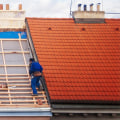Flat roofs have become increasingly popular in the last decade, offering homeowners and business owners alike a variety of benefits. From improved energy efficiency to greater aesthetic appeal, flat roofs offer a range of advantages that make them an attractive option for many. However, flat roofs can also present a number of challenges, from drainage issues to maintenance requirements. This article provides a comprehensive overview of flat roofs, exploring the potential benefits and drawbacks of the design. We'll start by examining the different types of flat roof available, from single-ply membrane systems to modified bitumen.
We'll then look at the advantages and disadvantages of flat roofs, including how they compare to other types of roofing systems. Finally, we'll discuss the essential considerations when installing a flat roof, such as materials, installation techniques and maintenance procedures. Whether you're looking to replace your existing roof or simply want to learn more about flat roofs, this article has something for everyone.
Maintaining And Repairing Flat Roofs
Regular maintenance and repair is essential to ensuring your flat roof lasts for years to come. Here are some tips on how to keep your flat roof in good condition:Inspect the Roof Regularly:It is important to inspect your flat roof at least twice a year. Look for any signs of damage, such as cracks, tears, or punctures in the roofing material.Also, check for any broken or missing shingles or tiles and any signs of water damage. Make sure to check the flashing, as it can be an area of weakness in the roof.
Check for Pooling Water:
Flat roofs can often be prone to pooling water, so it is important to check for this regularly. If you notice water gathering in certain areas, it could be a sign of a leak or poor drainage system. It is important to address these issues quickly to avoid further damage.Clean the Gutters:
It is important to keep the gutters clean to ensure that water does not accumulate on the roof or around the foundation of your home.Make sure to clean the gutters of debris and leaves regularly.
Repair Any Damage Quickly:
If you notice any signs of damage on your flat roof, it is important to address them quickly. Small repairs may be able to be done yourself, but if you are unsure, it is best to call a professional roofer. This will ensure that any repairs are done properly and that your flat roof is able to withstand the elements.Types of Flat Roofs
Flat roofs come in a variety of materials, each with its own advantages and disadvantages. The most common types of flat roofs are built-up roofing (BUR), single-ply membranes, and modified bitumen.Built-up Roofing (BUR)Built-up roofing is the most popular type of flat roof. It is a multi-layer system composed of alternating layers of asphalt and reinforcing fabrics such as fiberglass. The fabric and asphalt layers are combined to create a strong waterproof surface that can last for decades. The downside to BUR is that it can be expensive to install and maintain.
Single-Ply MembranesSingle-ply membranes are a type of roofing material that is typically made of rubber or thermoplastic. These membranes are lightweight and easy to install, making them a popular choice for flat roofs. They can be installed in one layer, and they provide excellent waterproofing. However, they tend to be less durable than built-up roofs and may require more frequent maintenance.
Modified BitumenModified bitumen is a type of flat roofing material that is made from asphalt and plastic or rubber modifiers. It is often used as a layer in built-up roofs and provides excellent waterproofing as well as good durability. It can also be used on its own as a single-ply membrane.
Flat Roof Installation
Installing a flat roof can be tricky, but with the right tools and materials, you can get the job done quickly and effectively.Before you begin, it's important to make sure that you understand the different types of flat roofs available, as each type requires different materials and techniques for installation. Here's a guide to help you get started.
Types of Flat Roof Materials
The most common type of flat roof material is asphalt shingles. These are relatively easy to install and provide a durable, waterproof surface for your home. Other materials, such as metal or plastic, can also be used for flat roofs, but are more expensive and require more specialized installation techniques.Tools and Supplies Needed
Before you begin installing a flat roof, make sure you have all the necessary tools and supplies.This includes a ladder, tape measure, hammer, nails, shingle cutter, metal flashing, roofing felt, and sealant. You may also need additional supplies depending on the type of material you're using.
Installation Process
The installation process for a flat roof is fairly straightforward. First, measure and mark the area you intend to cover with the roofing material. Then, prepare the surface by removing any debris or old roofing material.Next, install the roofing felt to provide a barrier between your roof and the shingles or other roofing materials. Finally, install the shingles or other materials according to the manufacturer's instructions.
Conclusion
Installing a flat roof can be a difficult task for those who aren't experienced in roofing. However, with the right tools and materials, it is possible to complete the installation quickly and effectively. Make sure you understand the different types of flat roofs available and have all the necessary supplies before beginning your project.Choosing The Right Flat Roof For Your Home
When it comes to choosing the right flat roof for your home, there are several factors that should be taken into consideration.First and foremost, it's important to understand the different types of flat roofs available on the market. Each type of flat roof will have different advantages and disadvantages, so it's important to research each option thoroughly to make sure you're getting the best fit for your particular needs. The most common type of flat roof is a single-ply membrane. This type of roof is made from a single layer of material, usually either a rubber or plastic membrane.
It's generally cheaper than other types of flat roofs, and can be installed quickly with minimal tools and effort. However, it's important to note that single-ply membranes are not as durable as other options, and may need to be replaced more frequently. Another popular choice is a built-up roof (BUR). This type of flat roof consists of several layers of waterproof material, such as tar or asphalt, that are applied in alternating layers.
This type of roofing system is more expensive than single-ply membranes, but it is much more durable and can last up to 25 years with proper maintenance. Finally, the last type of flat roof is a standing-seam metal roof. This type of roof is made from sheets of metal that are connected together using a series of ridges and valleys. This type of roofing system is extremely durable and can last up to 50 years with proper maintenance.
However, it is also one of the most expensive types of flat roofs available on the market. Before deciding on the right flat roof for your home, it's important to consider your budget, the climate in your area, and the overall look you want for your home. If you have any questions or would like more information about flat roofs, contact a local roofing professional for advice.










